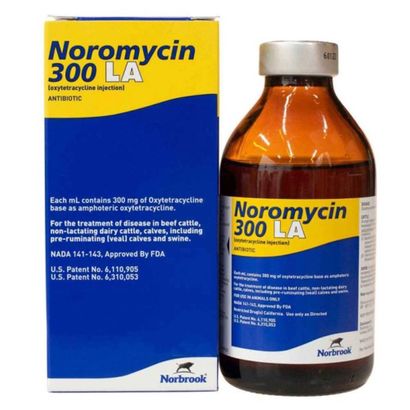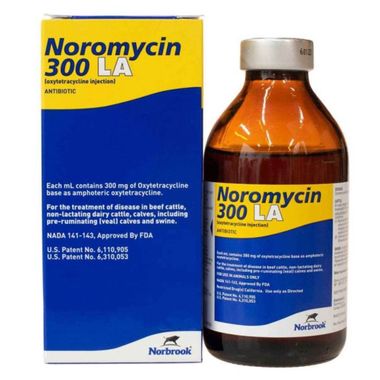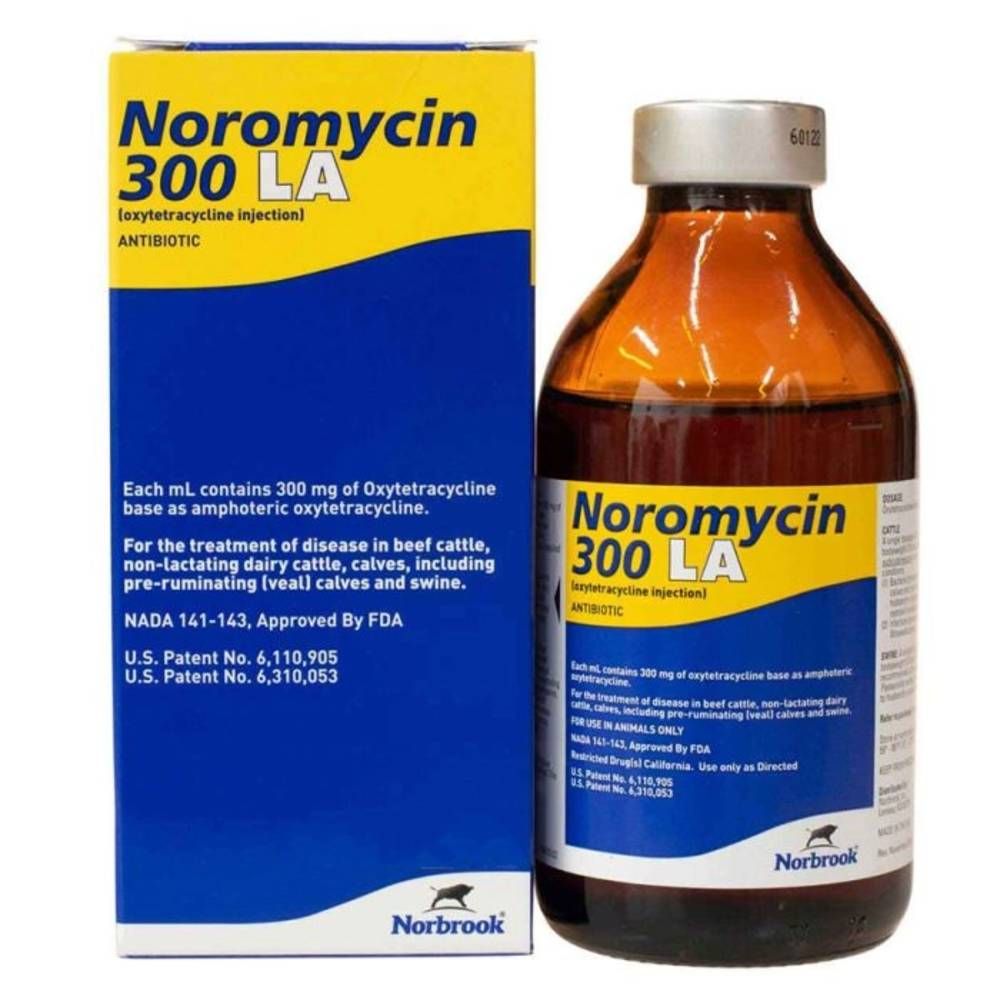SAVE 15% OFF 15% OFF Use Code EPX15 *

Noromycin 300 LA for Cattle - Injection Antibiotic 100ml
- Description
- Directions
- Reviews
Description
300 LA is indicated in the treatment of pneumonia and shipping fever complex associated with Pasteurella spp., and Histophilus spp. 300 LA is indicated for the treatment of infectious bovine keratoconjunctivitis (pink eye) caused by Moraxella bovis, foot-rot and diphtheria caused by Fusobacterium necrophorum; bacterial enteritis (scours) caused by Escherichia coli; wooden tongue caused by Actinobacillus lignieresii; leptospirosis caused by Leptospira pomona; and wound infections and acute metritis caused by strains of staphylococcal and streptococcal organisms sensitive to oxytetracycline. Also, it is indicated for the control of respiratory disease in cattle at high risk of developing BRD associated with Mannheimia (Pasteurella) haemolytica.
Animals Treated
- Cattle
- Beef Cattle
- Non-lactating Dairy Cattle
- Calves including pre-ruminating (veal) calves
- Swine
How It Works
300 LA is intended for use in treatment for diseases when due to oxytetracycline-susceptible organisms.
Indications
300 LA is intended for use in treatment for the following diseases when due to oxytetracycline-susceptible organisms
Beef cattle, non-lactating dairy cattle, calves, including pre-ruminating (veal) calves:
300 LA is indicated in the treatment of pneumonia and shipping fever complex associated with Pasteurella spp., and Histophilus spp. 300 LA is indicated for the treatment of infectious bovine keratoconjunctivitis (pink eye) caused by Moraxella bovis, foot-rot and diphtheria caused by Fusobacterium necrophorum; bacterial enteritis (scours) caused by Escherichia coli; wooden tongue caused by Actinobacillus lignieresi; leptospirosis caused by Leptospira pomona; and wound infections and acute metritis caused by strains of staphylococcal and streptococcal organisms sensitive to oxytetracycline. Also, it is indicated for the control of respiratory disease in cattle at high risk of developing BRD associated with Mannheimia (Pasteurella) haemolytica.
Swine:
300 LA is indicated in the treatment of bacterial enteritis (scours, colibacillosis) caused by Escherichia coli; pneumonia caused by Pasteurella multocida; and leptospirosis caused by Leptospira pomona.
In sows 300 LA is indicated as an aid in control of infectious enteritis (baby pig scours, colibacillosis) in suckling pigs caused by Escherichia coli.
Directions
Beef cattle, non-lactating dairy cattle, calves, including pre-ruminating (veal) calves:
A single intramuscular or subcutaneous dosage of 13.6 mg of oxytetracycline per pound of bodyweight, 300 LA is recommended for the control of respiratory disease in cattle at high risk of developing BRD associated with Mannheimia (Pasteurella) haemolytica.
At a single intramuscular or subcutaneous dose range of 9 to 13.6 mg of oxytetracycline per pound of bodyweight, 300 LA is recommended in the treatment of the following conditions:
- Bacterial pneumonia caused by Pasteurella spp (shipping fever) in calves and yearlings where retreatment is impractical due to husbandry conditions, such as cattle on range, or where their repeated restraint is inadvisable.
- Infectious bovine kertaconjunctivitis (pink eye) caused by Moraxella bovis.
For other indications 300 LA is to be administered intramuscularly, subcutaneously or intravenously at a level of 3 to 5 mg of oxytetracycline per pound of bodyweight per day. In treatment of foot-rot and advanced cases of other indicated diseases, a dosage level of 5 mg per pound of bodyweight per day is recommended. Treatment should be continued 24 to 48 hours following remission of disease signs, however, not to exceed a total of four (4) consecutive days. If improvement is not noted within 24 to 48 hours of the beginning of treatment, diagnosis and therapy should be re-evaluated.
Do not administer intramuscularly in the neck of small calves due to lack of sufficient muscle mass.
Use extreme care when administering this product by intravenous injection. Perivascular injection or leakage from an intravenous injection may cause severe swelling at the injection site.
Swine:
A single dosage of 9 mg of oxytetracycline per pound of bodyweight administered intramuscularly is recommended in the treatment of bacterial pneumonia caused by Pasteurella multocida in swine, where retreatment is impractical due to husbandry conditions or where repeated restraint is inadvisable.
300 LA can also be administered by intramuscular injection at a level of 3 to 5 mg of oxytetracycline per pound of bodyweight per day. Treatment should be continued 24 to 48 hours following remission of disease signs; however, not to exceed a total of four (4) consecutive days. If improvement is not noted within 24 to 48 hours of the beginning of treatment, diagnosis and therapy should be re-evaluated.
For sows, administer once intramuscularly 3 mg of oxytetracycline per pound of bodyweight approximately eight (8) hours before farrowing or immediately after completion of farrowing as an aid in the control of infectious enteritis in baby pigs.
For swine weighing 25 lbs of bodyweight and under, 300 LA should be administered undiluted for treatment at 9 mg/lb but should be administered diluted for treatment at 3 or 5 mg/lb.
| 9 mg dosage of undiluted 300 LA | 3 or 5 mg/lb volume of diluted 300 LA | |||
|---|---|---|---|---|
| Bodyweight | 9 mg/lb | 3 mg/lb | Dilution* | 5 mg/lb |
| 5 lb | 0.15 mL | 0.4 mL | 37.5 mg/mL | 0.7 mL |
| 10 lb | 0.30 mL | 0.6 mL | 50 mg/mL | 1.0 mL |
| 25 lb | 0.75 mL | 1.0 mL | 75 mg/mL | 1.7 mL |
* To prepare dilutions, add one part of 300 LA to three (3), five (5) or seven (7) parts of sterile water, or 5% dextrose solution as indicated; the diluted product should be used immediately.
Precautions:
Exceeding the highest recommended level of drug per pound of bodyweight per day ...
Storage:
Store at room temperature, 59-86°F (15-30°C). Keep from freezing.
Warnings:
Discontinue treatment at least 28 days prior to slaughter ...
Caution:
Intramuscular or subcutaneous injection may result in local tissue reactions ...
Adverse Reactions:
Reports of adverse reactions associated with oxytetracycline administration ...
Pharmacology:
Oxytetracycline is derived from the metabolic activity of Streptomyces rimosus ...
Studies have shown that the half-life of oxytetracycline in blood following intramuscular treatment with 300 LA at 5 mg per pound of bodyweight is approximately 23 hours in cattle and 18 hours in swine.
Studies have shown when 300 LA is administered once intramuscularly to cattle or swine at 9 mg per pound of bodyweight, blood oxytetracycline concentrations ...
Studies have shown when 300 LA is administered once intramuscularly or subcutaneously to cattle at 13.6 mg per pound ...


